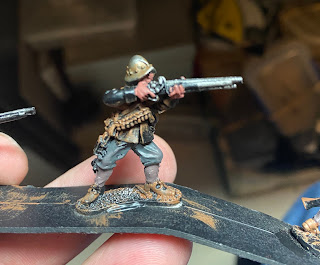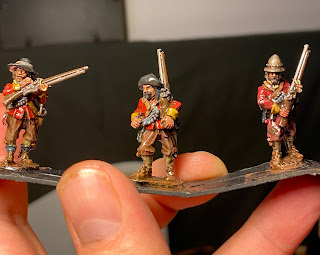So with one shotte sleeve mounted on card I sprayed them with black.
Next comes the fun bit, over the black undercoat I dry brushed a layer of leather brown. This was then given another layer of slightly lighter leather drown. These quick coats of paint take care of the bandoliers, belts, sword scabbards, shoes and some head ware.
After this I start to block in the flat colours starting with the trousers. I chose a grey colour but after doing four or five started mixing in other browns to vary it. A red was also added, you can’t really go wrong in this bit as long as all the colours look muted and natural.
I found a photo ref off the internet and this will act as a guide. This is as far as I got last night after dry brushing on the metal for the sword and gun barrel. Next up I will carefully block in the red tunic around the leather belts. If I found myself with any light brown or grey on my brush I gave certain coloured areas a quick dry brush. This is great for knees and seats of trousers.
I will be doing two layers on my flesh as I think it’s an area of weakness when painting minis for Army Painter Dip. A little extra time here should really pay off on the finished piece.
I think dry brushing the leather brown really looks good and takes care of around 40% of the figure in one go. The rest is flat colours with the odd dust stain on the knee and elbow. Painted in strips of five this lot took me two hours so far, Sir Spencer Redmond’s Regiment of Foote has started to arrive.
Creating new imaginary regiments I have to say is a massive part of this project for me. It breaths so much more fun and enjoyment into the game. My wives regiment is almost completed and should be finished in the next day or two.
A huge part of the fun comes from creating new standards and a huge shout goes out to Flags of War, where you can design your very own unique ones. It’s a very novel idea and really helps to personalise your armies and games. I have already bought enough sets of custom standards to account for most of my close friends and family. For campaign games it will really come into it own with units becoming veteran etc. I highly recommend popping along and checking out the create your own standard feature for all the reasons above. All arms of the armies are covered including horse and Dragoons. Recommend!
Back to the painting, here you see the next stage where the coats and flesh have been blocked in. As the cuffs are going to be yellow to match the standard, I went with Vallejo golden brown. This is a great undercoat for yellow, however in this case I will be leaving like this as it’s a nice muted colour. The brown Dip should shade it really nicely. Not far to go now just the hats and musket stock to go.
So with the black hats and wood stocks done I give it a once over with a keen eye, touching up any mistakes. This is always worth doing as there are always a couple of corkers. The musket fuses for one!l
Before I Dipped I went over any areas I wanted the detail to stand out in, with black ink (Nuln oil). This was the entire musket and the bandolier, powder flasks, buckles, armour and sword hilts. Anything black too like hats got a wash ( they were painted with Corvus black to start with) so the ink helped shade them. Doing this helps bring a greater sense of contrast to these areas.
Now they are ready for the Dip. When I Dip I give the can a good stir with a stick. This is important as I drip some of the thick dark stuff from the bottom into the lid. I use this as the really dark stuff for shading certain colours like brown and red. For lighter shades of brown, yellows and greys, I dip the brush into the top of the can where the solution is weaker. Doing it this way gives a tiny bit of control over how dark the shade is, but still making sure the model is nicely varnished.
Selecting some of the thick, strong stuff from the bottom for the darker colours.
The dry brushing on the knees and elbows should really pay off now, for the Dip once applied really helps differentiate between colours, even those that were very close in hue before the Dip. Leave these for at least three nights to dry before spraying with matte varnish. More on that latter.
The real star of this process is the figures themselves, a well sculpted mini will always look good with this Dip method. The sculpting in the face and on the clothes of these figures is fantastic and does all the work for you really.
Once the figures are dry from the matte varnish, I brush any metal work with GW chain mail again to replace the shine that was lost in the varnish.
Once this is done I base them up. At the start I hand picked the figures and arranged them on the bases now it’s just a case of arranging them again in their places. My new method is to place four figures in the front rank, I think this looks more dynamic and chaotic than three.































2 comments:
Your figures are coming out great with this speedy method. Can't wait to see them based up and finished.
The Dip certainly helps get stuff done that is for sure.
Post a Comment